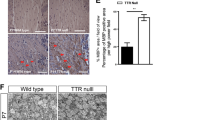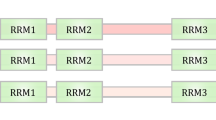Abstract
Neurotrophins acting through Trk signal-transducing receptors play essential roles in the nervous system, and probably in some non-neuronal tissues. In the present study, we used RT-PCR, Western-blot and immunohistochemistry to investigate the occurrence and cellular localization of TrkB in the mouse liver, from newborns to 6 months. Furthermore, the structure of the liver in mice carrying a mutation in the trkB gene, resulting in a non-functional protein, was studied. The analysis of the DNA sequence showed that hepatic trkB gene is identical to the cerebral one, and TrkB mRNA and TrkB full-length protein (145 kDa) were detected at all the ages sampled. Immunohistochemistry revealed age-dependent changes in the pattern of TrkB expression. From 0 to 15 days, the TrkB was detected in morphologically and immunohistochemically identified monocyte-macrophage-dendric cells scattered throughout the organ, while in animals 3- and 6-months-old it was restricted to nerve fibres. Interestingly, there was a parallelism between TrkB expression by monocyte-macrophage-dendric cells and the presence of hepatic erythroblastic islands. In agreement with a possible role of TrkB on hepatic haematopoiesis, the liver of 15 days old TrkB (-/-) mice still contained erythroblastic islands, whereas they were absent in the wild-type littermates. Another striking finding was the absence of nerve profiles in the TrkB (-/-) animals. All together, present results support the role of TrkB in the murine liver in maintaining the innervation of the organ, and more importantly throughout an unknown mechanism in controlling the hepatic haematopoietic function.







Similar content being viewed by others
References
Aloe L, Skaper SD, Leon A, Levi-Montalcini R (1994) Nerve growth factor and autoimmune diseases. Autoimmunity 19:141–150
Austyn JM, Gordon S (1981) F4/80, a monoclonal antibody directed specifically against the mouse macrophague. Eur J Immunol 11:805–811
Botchkarev VA, Metz M, Botchkareva NV, Welker P, Lommatzsch M, Renz H, Paus R (1999) Brain-derived neurotrophic factor, neurotrophin-3, and neurotrophin-4 act as “epitheliotrophins” in murine skin. Lab Invest 79:557–572
Braun A, Lommatzsch M, Mannsfeldt A, Neuhaus-Steinmetz U, Fischer A, Schnoy N, Lewin GR, Renz H (1999) Cellular sources of enhanced brain-derived neurotrophic factor production in a mouse model of allergic inflammation. Am J Respir Cell Mol Biol 21:537–546
Cassiman D, Denef C, Desmet VJ, Roskams T (2001) Human and rat hepatic stellate cells express neurotrophins and neurotrophin receptors. Hepatology 33:148–158
Cassiman D, Libbrecht L, Desmet V, Denef C, Roskams T (2002) Hepatic stellate cell/myofibroblast subpopulations in fibrotic human and rat livers. J Hepatol 36:200–209
Chao MV (2003) Neurotrophins and their receptors: a convergence point for many signalling pathways. Nat Rev Neurosci 4:299–309
Frisen J, Verge VM, Fried K, Risling M, Persson H, Trotter J, Hokfelt T, Lindholm D (1993) Characterization of glial trkB receptors: differential response to injury in the central and peripheral nervous systems. Proc Natl Acad Sci USA 90:4971–4975
Fariñas I (1999) Neurotrophin actions during the development of the peripheral nervous system. Microsc Res Tech 45:233–242
García-Suárez O, Hannestad J, Esteban I, Sainz R, Naves FJ, Vega JA (1998) Expression of the TrkB neurotrophin receptor by thymic macrophages. Immunology 94:235–241
García-Suárez O, Germanà A, Hannestad J, Ciriaco E, Laurà R, Naves J, Esteban I, Silos-Santiago I, Vega JA (2000) TrkA is necessary for the normal development of the murine thymus. J Neuroimmunol 108:11–21
García-Suárez O, Blanco-Gelaz MA, López ML, Germanà A, Cabo R, Silos-Santiago I, Ciriaco E, Vega JA (2002) Massive lymphocyte apoptosis in the thymus of functionally deficient TrkB mice. J Neuroimmunol 129:25–34
Hempstead BL (2002) The many faces of p75NTR. Curr Opin Neurobiol 12:260–267
Huang EJ, Reichardt LF (2001) Neurotrophins: roles in neuronal development and function. Annu Rev Neurosci 24:677–736
Huang EJ, Reichardt LF (2003) Trk receptors: roles in neuronal signal transduction. Annu Rev Biochem 72:609–642
Katoh-Semba R, Kaisho Y, Shintani A, Nagahama M, Kato K (1996) Tissue distribution and immunocytochemical localization of neurotrophin-3 in the brain and peripheral tissues of rats. J Neurochem 66:330–337
Katoh-Shemba R, Takeuchi IK, Semba R, Kato K (1997) Distribution of brain-derived neurotrophic factor in rats and its changes with development in the brain. J Neurochem 69:34–42
Klein R, Smeyne RJ, Wurst W, Long LK, Auerbach BA, Joyner AL, Barbacid M (1993) Targeted disruption of the trkB neurotrophin receptor gene results in nervous system lesions and neonatal death. Cell 75:113–122
Lommatzsch M, Braun A, Mannsfeldt A, Botchkarev VA, Botchkareva NV, Paus R, Fischer A, Lewin GR, Renz H (1999) Abundant production of brain-derived neurotrophic factor by adult visceral epithelia. Implications for paracrine and target-derived Neurotrophic functions. Am J Pathol 155:1183–1193
Lommatzsch M, Quarcoo D, Schulte-Herbruggen O, Weber H, Virchow JC, Renz H, Braun A (2005) Neurotrophins in murine viscera: a dynamic pattern from birth to adulthood. Int J Dev Neurosci 23:495–500
Nemoto K, Fukamachi K, Nemoto F, Miyata S, Hamada M, Nakamura Y, Senba E, Ueyama T (1998) Gene expression of neurotrophins and their receptors in cultured rat vascular smooth muscle cells. Biochem Biophys Res Commun 245:284–288
Nemoto K, Miyata S, Nemoto F, Yasumoto T, Murai U, Kageyama H, Degawa M (2000) Gene expression of neurotrophins and their receptors in lead nitrate-induced rat liver hyperplasia. Biochem Biophys Res Commun 275:472–476
Perez-Perez M, Garcia-Suarez O, Esteban I, Germana A, Farinas I, Naves FJ, Vega JA (2003) p75NTR in the spleen: age-dependent changes, effect of NGF and 4-methylcatechol treatment, and structural changes in p75NTR-deficient mice. Anat Rec 270:117–128
Roggin KK, Kim JC, Kurkchubasche AG, Papa EF, Vezeridis AM, Tracy TF (2001) Macrophage phenotype during cholestatic injury and repair: the persistent inflammatory response. J Pediatr Surg 36:220–228
Roskams T, Cassiman D, de Vos R, Libbrecht L (2004) Neuroregulation of the neuroendocrine compartment of the liver. Anat Rec A 280A: 910–923
Sariola H (2001) The neurotrophic factors in non-neuronal tissues. Cell Mol Life Sci 58:1061–1066
Sasaki K, Iwatsuki H (1997) Origin and fate of the central macrophages of erythroblastic islands in the fetal and neonatal mouse liver. Microsc Res Tech 39:398–405
Sasaki K, Iwatsuki H, Suda M, Itano C (1993) Scavenger macrophages and central macrophagues of erythroblastic islands in liver hemopoiesis of the fetal and early postnatal mouse: a semithin light- and electron- microscopic study. Acta Anat 147:75–82
Shibayama E, Koizumi H (1996) Cellular localization of the Trk neurotrophin receptor family in human non-neuronal tissues. Am J Pathol 148:1807–1817
Tessarollo L (1998) Pleiotropic functions of neurotrophins in development. Cytokine Growth Factor Rev 9:125–137
Tiniakos DG, Lee JA, Burt AD (1996) Innervation of the liver: morphology and function. Liver 16:151–160
Vega JA, Garcia-Suarez O, Hannestad J, Perez-Perez M, Germana A (2003) Neurotrophins and the immune system. J Anat 203:1–19
Yamamoto M, Sobue G, Yamamoto K, Terao S, Mitsuma T (1996) Expression of mRNAs for neurotrophic factors (NGF, BDNF, NT-3, and GDNF) and their receptors (p75NGFR, TrKA, TrKB , and TrKC) in the adult human peripheral nervous system and nonneural tissues. Neurochem Res 21:929–993
Zapata DA, Pacheco-Castro A, Torres PS, Ramiro AR, San José E, Alarcón B, Alibaud L, Rubin B, Toribio ML, Regueiro JR (1999) Conformational and biochemical differences in the TCR–CD3 complex of CD8+ versus CD4+ mature lymphocytes revealed in the absence of CD3γ. J Biol Chem 274:35119–35128
Zhou XF, Rush RA (1993) Localization of neurotrophin-3-like immunoreactivity in peripheral tissues of the rat. Brain Res 621:189–199
Acknowledgements
This work was supported in part by grants from Spanish DGICYT (CC-99-SAF-0119-CO2O2), and Maratò TV3. The authors thank Dr. J.L. Martinez (Servicio de Secuenciación, Servicios Comunes de Investigación, Universidad de Oviedo) for trkB gene sequencing; Mr. M. Montero Acosta for stylistic review of the manuscript; Dr. K. Sasaki (Kawasaki Medical School, Kurashiki, Japan), and Prof. A.G. Zapata (Universidad Complutense de Madrid, Spain) for critical reading of the manuscript.
Author information
Authors and Affiliations
Corresponding author
Rights and permissions
About this article
Cite this article
García-Suárez, O., González-Martínez, T., Perez-Perez, M. et al. Expression of the neurotrophin receptor TrkB in the mouse liver. Anat Embryol 211, 465–473 (2006). https://doi.org/10.1007/s00429-006-0098-9
Accepted:
Published:
Issue Date:
DOI: https://doi.org/10.1007/s00429-006-0098-9




